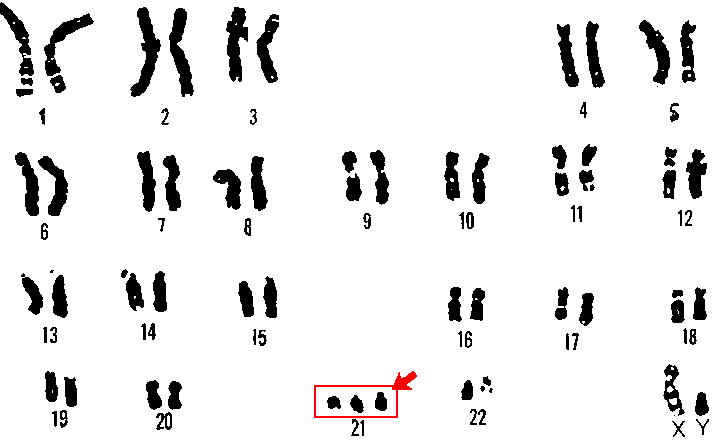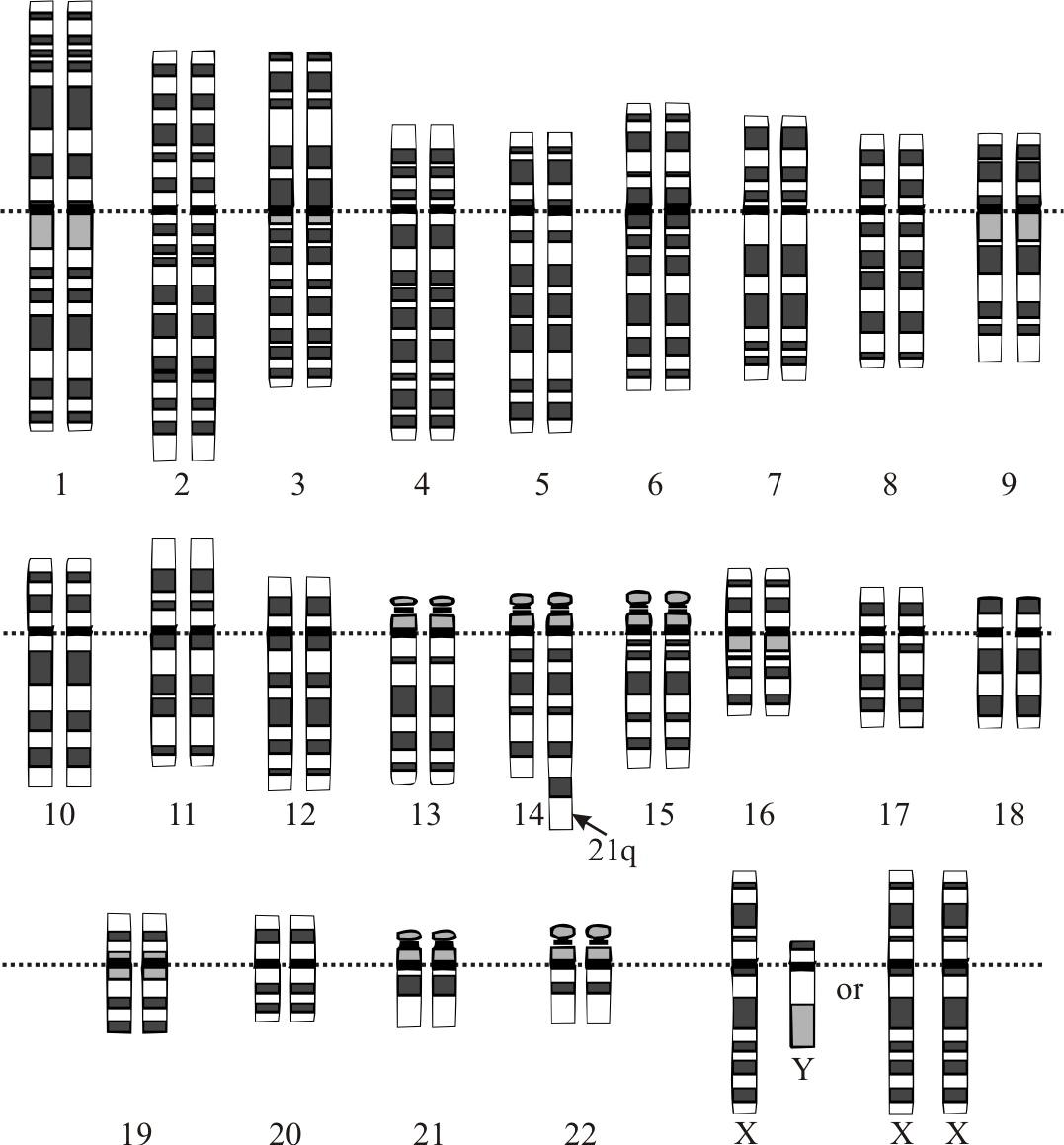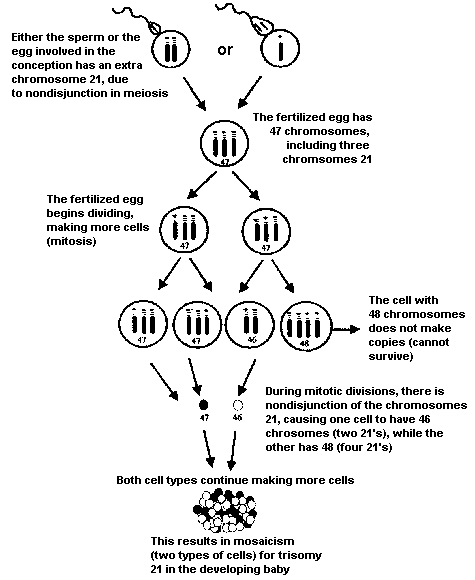Category — 2.1 Children with Genetic Disorders: Down Syndrome
Children with Down’s Syndrome
Down syndrome is the most frequent genetic cause of mild to moderate intellectual disability. It is a chromosomal disorder (see full Glossary) caused by an error in the cell division shortly after conception. This error results in a third chromosome 21, or an extra part of chromosome 21, or “Trisomy 21” as shown in this picture (Fig. 1). The error in cell division can happen in different ways. These include the following: chromosomal nondisjunction (see full Glossary), translocation (see full Glossary) (Fig. 2) or mosaicism (see full Glossary) (See Chart on Fig. 3).
Figure 1. “Trisomy 21”
Figure 1 points at “pair” 21 with an extra or third chromosome. This is replicated in every cell of the body
Figure 2. Down Syndrome Translocation
Figure 2 shows how part of a chromosome added to pair 14 and re-arranged the genes
Figure 3. Mosaicism
Figure 3 shows another error in cell division for pair 21. This time, however, not all cells have the three chromosomes as in Trisomy 21 (see Figure 1)
Description
Children with Down Syndrome have different physical characteristics that include the following (see Fig. 4):
Typical characteristics include the following:
- Hypotonia, or low muscle tone;
- Upward slant of the eyes;
- Epicanthal folds (see full Glossary)
- Small mouth;
- Small stature;
- Flattened back of the head;
- Short broad hands with a ‘simian’ crease (see full Glossary)
- ‘Brushfield’ spots (see full Glossary)
- Hyperflexibility or hypermobility (see full Glossary) in the joints (Fig. 5);
Figure 4. Physical characteristics of children with Down Syndrome
Figure 5. Hypermobility
Figure 5 points at the joint of the index finger in a child with Down’s Syndrome. The joint is curved, not straight
Health Conditions
- Children with Down Syndrome are at higher risk than other children for infections, and other health problems including respiratory problems and leukemia.
- It is common for children with Down Syndrome to experience sensory impairments, including vision impairments and/or with hearing loss
- Some children with Down Syndrome (DS) may have congenital heart defects Congenital heart defects (see full Glossary)
Developmental Delays
- Children with Down Syndrome experience developmental delays including cognitive delays or intellectual disability – (See more here)
- In terms of other developmental conditions, 10% of children with Down Syndrome also have autism or ASD
Intervention options:
Children with Down Syndrome have different health and overall development needs. These needs require special attention in terms of the child’s education as he or she grows up. Different professionals or services may be required to support these needs. They include the following:
- IDP, AIDP and SCDP, ASCD: Infants with Down’s syndrome in British Columbia, Canada will be first referred to the Infant Development Program, IDP, or Aboriginal Infant Development Program, AIDP. Children ages 3 and older will be referred to the Supported Child Development Program, SCDP, and Aboriginal Supported Child Development Program ASCD. Each one of these agencies will provide developmental consultation for children with Down Syndrome (or DS)1. Services range between birth and age 19 years. Each organization serves children at particular ages (please refer to each agency. IDP and AIDP: Birth to 3 years; SCD/ASCDP: 3 – 19 years);
- Physiotherapist (PT): He or she will address decreased tone or floppiness in the large muscle or gross motor area;
- Occupational therapist (OT): He or she will address decreased tone or floppiness in the small muscle or fine motor area, and/or in the muscles around the mouth or oral-motorarea;
- Speech Language Therapist (SLP): He or she will address any difficulties with speech and language. This includes difficulties related to the muscles around the mouth or oral-motor area;
- Mental health: These agencies will provide mental health support for older children and teens with DS. Other children and adults may pick on these because of their differences. These children are more vulnerable to bullying and harassing;
- Vision and hearing specialist: Children with DS often have vision and hearing challenges. It is important to check their vision and hearing on a regular basis;
Other specialist may include the following:
- Public Health Nurse (or Community Health Nurse)
- Pediatric Cardiologist
- Pediatric Ophtalmogist
- Vision Consultant
- Hearing Specialists
- Ear-nose-throat doctor
- Hearing/resource teacher
- Assistive technologies and devices: These may be used to help children with DS develop certain cognitive, social and/or academic skills; Assistive technologies include amplification such as hearing aids, FM systems, cochlear implants
- Alternative therapies: (see full Glossary) These may be used to enhance the child’s health and digestion
To learn about Down Syndrome in the middle childhood years, please visit the six to 12 part of this course:
1. Many online resources are available for parents and service providers.
March 10, 2011 No Comments




